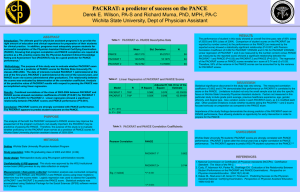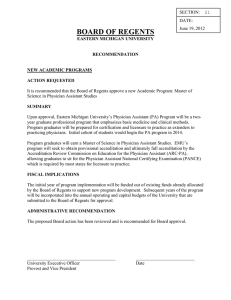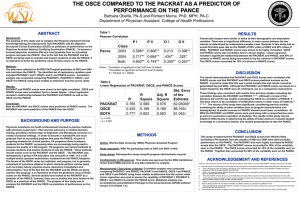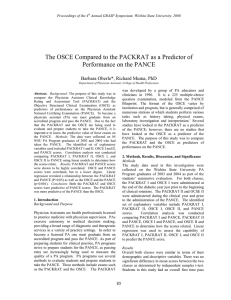PACKRAT: A Predictor of Success on the PANCE Submitted by
advertisement
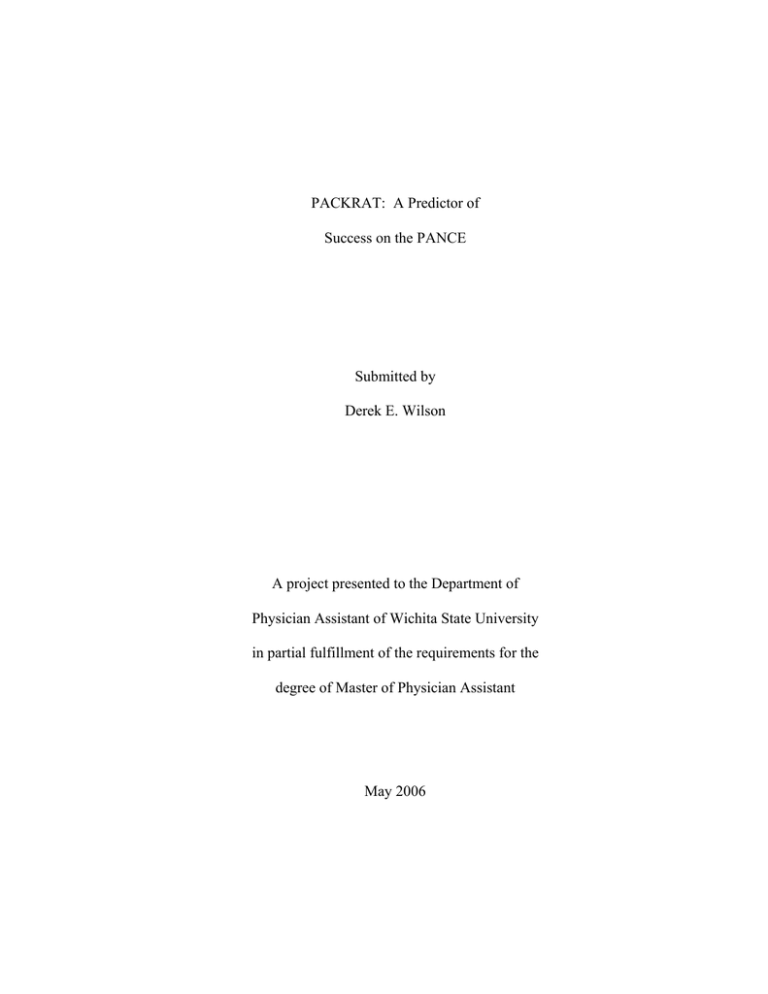
PACKRAT: A Predictor of Success on the PANCE Submitted by Derek E. Wilson A project presented to the Department of Physician Assistant of Wichita State University in partial fulfillment of the requirements for the degree of Master of Physician Assistant May 2006 Wichita State University College of Health Professions Department of Physician Assistant We hereby recommend that the research project prepared under our supervision by Derek E. Wilson entitled PACKRAT: A predictor of success on the PANCE be accepted as partial fulfillment for the degree of Master of Physician Assistant. Approved: __________________________________________________________ Richard D. Muma, PhD, MPH, PA-C, Chair and Associate Professor Department of Physician Assistant __________________________________________________________ PA Program Faculty Advisor (Richard D. Muma, PhD, MPH, PA-C) Department of Physician Assistant May 9, 2006 Date i Abstract Introduction: The ultimate goal for physician assistant programs is to provide the right amount of education and clinical experience for preparation of their students for clinical practice. In addition, programs must adequately prepare students for successful completion of the Physician Assistant National Certifying Examination (PANCE). Knowing that program completion and PANCE completion are required to practice as a PA, practice exams like the Physician Assistant Clinical Knowledge Rating and Assessment Tool (PACKRAT) may be a good predictor for PANCE performance. Methodology: The purpose of this study was to evaluate whether PACKRAT exam scores served as a predictor of PANCE scores for Wichita State University PA classes 2003-2004. The data of interests included PACKRAT 1 (administered at the end of the first year), PACKRAT 2 (administered at the end of the second year), and PANCE exam raw scores (administered after graduation). The relationship between the scores was evaluated by determination of the correlation coefficient. Analysis of the predictive value of PACKRAT results with respect to passing the PANCE was accomplished using linear regression. Results: Combined correlations of the class of 2003-2004 between PACKRAT and PANCE scores showed correlation coefficients of 0.602 (P<0.001) for PACKRAT 1 and 0.744 (P<0.001) for PACKRAT 2. Linear regression showed a significant relationship between PACKRAT scores and PANCE performance (P<0.001). Conclusion: PACKRAT scores are strongly correlated with PANCE performance. The PACKRAT appears to predict student outcome on the PANCE. ii Table of Contents LIST OF TABLES……………………………………………………………………….iv ACKNOWLEDGEMENTS………………………………………………………………v CHAPTER I. INTRODUCTION……… ……………………………………………… 1 II. LITERATURE REVIEW ……….………………………………………. 5 III. METHODOLOGY…………………………..…………………………... 6 IV. RESULTS AND DATA ANALYSIS…...……………………………….. 7 V. DISCUSSION…………………………………………………………....10 REFERENCES……………………………………………………………......................13 VITA……………………………………………………………………………………..15 iii List of Tables 1. PANCE Blueprint: Knowledge and Skill Areas………………………………… 2 2. PANCE Blueprint: Body Systems………………………………………………. 3 3. WSU PA Class 2003 and 2004 Demographic Profile…..……………………….. 8 4. PANCE VS PACKRAT Descriptive Data……………………………………….. 9 5. PANCE VS PACKRAT Correlation Coefficients……………………………….. 9 6 Linear Regression PANCE and PACKRAT Scores……………………………..10 iv Acknowledgements I would like to take an opportunity to thank my family and friends for their encouragement, motivation, and inspiration during my education. In addition, I’d like to thank the Wichita State University Physician Assistant program and my research advisor, Richard Muma, for their continuing assistance on this project. Finally, I’d like to thank every educator that has guided me in my learning career. v 1 Introduction Today, Physician Assistants (PAs) are formally educated, nationally certified healthcare providers who perform evaluative, diagnostic and therapeutic skills under the supervision of a physician1. Credentials and standards of education is a hallmark of the PA profession. Today, there are more than 134 programs offering professional certificates, baccalaureate degrees, and master’s degrees. While programs differ in design, sequencing, content, and degree, they all must comply with minimal benchmarks for accreditation by the Accreditation Review Commission on the Education of Physician Assistants (ARC-PA). The ARC-PA protects the interests of the public and PA profession by defining the standards for PA education and evaluating PA educational programs nationwide2. All PA curricula offer course study in basic medical science, clinical academic science, anatomy, physiology, pathophysiology, pharmacology, laboratory medicine, patient assessment, patient interviewing, medical history, physical examination, and medical literature review in order to meet ARC-PA criteria. The ultimate goal for PA programs is to provide the right amount of education and clinical experience for preparation in clinical practice. In addition, programs must adequately prepare students for successful completion of the Physician Assistant National Certifying Examination (PANCE). In order to be eligible for the PANCE, students must graduate from an accredited training program. Although the ultimate goal for programs is to produce qualified PA’s for clinical practice, it is essential for these students to successfully complete the PANCE in order to practice medicine. As a result, programs that balance the need for recommended coursework from the ARC-PA, and their own 2 individual additional coursework emphasized by local curricula committees, produce a final product that exhibits all the characteristics of a competent PA. As stated earlier, upon graduation of an accredited PA program, one becomes eligible to take the PANCE. The PANCE is a, computer based, exam that assesses complete medical knowledge with 360 multiple choice questions. New graduates must pass the exam within six attempts and within six years of graduation. The PANCE is organized using a blueprint of content. This blueprint consists of knowledge and skill areas and diseases, disorders, and medical assessment in a number of areas.3 (Tables 1 and 2) Table 1 PANCE Blueprint: Knowledge and Skill Areas Tasks History Taking & Physical Examinations Using Laboratory & Diagnostic Studies Formulating Most Likely Diagnosis Health Maintenance Clinical Intervention Pharmaceutical Therapeutics Applying Basic Science Concepts Total % of Exam Content 16 14 18 10 14 18 10 100 3 Table 2 PANCE Blueprint: Body Systems Organ System % of Exam Content Cardiovascular Pulmonary Endocrine EENT Gastrointestinal/Nutritional Genitourinary Musculoskeletal Reproductive Neurologic Pyschology/Behavioral Dermatologic Hematologic Infectious Disease Total 16 12 6 9 10 6 10 8 6 6 5 3 3 100 The PANCE is increasingly being used to measure the effectiveness of a PA program. Furthermore, passing PANCE scores are crucial for obtaining or maintaining accreditation and in some areas, for Federal grant monies1. Knowing program and PANCE completion rates are vital for both the student and the program. In addition, there is an increased interest in exams that help both entities prepare for the PANCE. One such exam is the Physician Assistant Clinical Knowledge Rating and Assessment Tool (PACKRAT). Physician Assistant educators and clinicians developed the PACKRAT in 1996 to help prepare students for the PANCE. The PACKRAT is a 225 multiple choice question exam patterned off the PANCE by using the content blueprint as 4 a template4. This exam may be used as a tool to evaluate strengths and weakness for both the student and the program and to better prepare students for the PANCE. Purpose of the Study As an ever-growing profession, a physician assistants’ role as a health care provider increases as demand increases. Throughout this evolution, it is critical to stay abreast of the many changes that occur in healthcare. Furthermore, there is increase need to analyze and improve curricula and coursework as the face of healthcare changes. Due to increased competition for seats within programs from applicants with diverse age, experience, ethnicity and education, it is imperative that applicants succeed in PA programs and pass the PANCE. Nationally, approximately ten to fifteen percent of those who complete PA programs fail the NCCPA exam5. The ability to pass the certification exam is paramount to the profession and PA programs. The analysis of the both the PACKRAT compared to PANCE scores may improve the assessment of the program curriculum, but equally important, the PACKRAT may be predictive of passing the PANCE. Therefore, the purpose of this study is to evaluate whether proficiency on the PACKRAT exam serves as a predictor of PANCE scores for Wichita State University physician assistant classes of 2003-2004. Wichita State data was collected on the basis of convenience to the researcher and not representative of national data. The data collected includes WSU PA graduate PACKRAT and NCCPA scores from the classes of 2003-2004. In summary, by understanding that every program invests interest and assessment in students’ successful completion of coursework, passing of the PANCE, and entry into 5 a challenging career, there is a need to evaluate the usefulness of preparation tests like the PACKRAT in correlation to passing the PANCE. Literature Review A review of literature was undertaken using Medline and CINAHL databases. The search was aided by using keywords such as PANCE, PACKRAT, NCCPA, ARCPA, credentialing-examinations, and Association of Physician Assistant Programs (APAP). In Lary’s Doctoral dissertation, she critically analyzed demographic and academic variables that predicted success on the PANCE exam. She recorded historical data from 429 Wichita State University physician assistant past students from the years 1986 to 1990. The variables included age, gender, ethnicity, length and level of health care experience, and academic degree type. Study results showed that previous health care experience, gender, and academic degree type, prior to starting the program, were not success predictors for either program completion or passing of the PANCE. Also, the study predicted that students older than 40 years had a lower program completion rate and lower success on the PANCE. Finally, non-Caucasian students had a significant lower rate of program completion and passing PANCE score5. Many authors have studied selection criteria, program designs, and other predictive variables that predict success on the PANCE. In one such study, a correlation between student grade point average in the third academic trimester of the didactic year correlated to PANCE scores. However, this study was limited by a small population size of n=88 6. McDowell et al studied relationships between components of PA education and performance on PANCE using variables like degree granted (Master of Science 6 versus Bachelor of Science), curriculum length, and age of program in accredited years. The results of this study found a positive correlation between the master’s degree and higher average pass rate on the PANCE. Curriculum length or duration in months had no significance upon the PANCE scores. However, the longer the program’s accreditation, the better students performed on the PANCE7. Hooker et al attempted to determine if differences in attributes of physician assistant programs explain variation of PANCE performance. This five year study occurred between 1997-2001 examining type of institution (private versus public), type of degree, Carnegie higher education typology for the institution (undergraduate versus graduate level research I and II institutions), class size, duration of program, age, gender, and tuition cost. This study concluded that none of the mentioned variables had a meaningful association with PANCE performance resulting in an increased interest to study other variables like individual and psychological predictors of PANCE success.8 Cody et al looked into the relationship between student scores on the PACKRAT and performance on the PANCE. This study monitored students who took the PACKRAT their first and second years compared to their PANCE scores. Their study concluded strong correlation between the PACKRAT with student performance on the PANCE. The passing of the PACKRAT proved significant in predicting students’ pass or fail performance on the PANCE.4 Methods Data for this study were collected from historical records held and maintained in the Wichita State University Physician Assistant Department administrative office. The identified set of explanatory variables included PACKRAT 1, PACKRAT 2, and PANCE 7 scores and demographic variables. The study data used in this investigation were from the WSU PA graduating class of 2003 and class 2004. This data corresponds to the first time NCCPA data was made available by individual student name, which could be matched to PACKRAT scores. The sample size consisted of 84 students who had completed the program and had taken the PANCE after completing the program. Physician Assistant National Certifying Examination scores represent only first time test administration. For both classes, the PACKRAT 1 was administered at the end of the didactic year just prior to the beginning of the clinical rotations. The PACKRAT 2 was administered following the clinical year and prior to the administration of the PANCE. Correlation analysis was conducted comparing PACKRAT 1 and PANCE; and PACKRAT 2 and PANCE scores using linear models to determine how the scores relate. Logistic regression was used to assess the Capability of PACRAT 1 and PACRAT 2 to predict the PANCE score. Statistical analysis was accomplished using Statistical Package for the Social Sciences (SPSS) software version 12.0. Results A total sample of 84 students from the WSU PA graduating class of 2003 and 2004 were studied. Table 3 depicts the demographics for each class. 8 Table 3 WSU PA Class of 2003 and 2004 Profile Class of 2003 Class of 2004 Age Average Range 29.88 21 - 51 28.6 20 - 51 Gender Male Female 13 33 12 36 32.8 0 - 180 41.8 2.9 - 142.8 13 9 20 4 11 4 27 4 Overall GPA High Low Average 4.0 3.0 3.65 4.0 3.0 3.66 Prerequisite GPA High Low Average 4.0 3.06 3.63 4.0 3.06 3.62 Healthcare Experience (# of Months) Average Range Degree None Associate Bachelor Graduate Descriptive statistics included data from both classes of 2003 and 2004 with a mean PANCE score of 490 (standard deviation +/- 95.24). Likewise, the mean for the PACKRAT 1 was 140.5 (standard deviation +/- 18.17). The mean for the PACKRAT 2 was 152.48 (standard deviation +/-13.76) (Table 4). 9 Table 4 PANCE vs. PACKRAT Descriptive Data Mean 490.1310 PANCE PACKRAT 1 140.5476 PACKRAT 2 152.4762 Std. Deviation N 95.23791 18.1675 13.76085 84 84 84 The performance of students in this study showed an overall first time pass rate of 95% (class of 2003) and 90% (class of 2004). Comparison of student scores on the PACKRAT (as reported by number correct) to the performance on the PANCE (as measured by the reported score) showed a statistically significant relationship (P<0.001) with a compared Pearson Correlation Coefficient of 0.602 for PACKRAT 1/PANCE and 0.744 for PACKRAT 2/PANCE (Table 5). Table 5 PACKRAT and PANCE Correlation Coefficients Pearson Correlation Sig. (1-tailed) PANCE PACKRAT 1 PACKRAT 2 *P<0.001 +P<0.001 0.602* 0.744+ Linear regression of PACKRAT 1 and 2 (as measured by the number correct) versus PANCE (as measured by the reported score) showed a significant relationship between the PACKRAT 1 and PANCE (P<0.05) and PACKRAT 2 and PANCE 10 (P<0.001). The regression of the PACKRAT scores on PANCE scores revealed an r score of 0.74 and r2 of 0.55. Therefore, 55% of the variance in the PANCE scores can be accounted for by the variance for PACKRAT scores (Table 6). Table 6 Linear Regression of PACKRAT and PANCE Scores Model R a PACKRAT 1 .765 PACKRAT 2 .744b a. p=.015 b. p=.000 Adjusted Std. Error of R Square R Square the Estimate 0.586 0.576 62.05009 0.554 0.548 63.99499 Discussion This study demonstrated that PACKRAT scores correlated with PANCE scores and the PACKRAT scores predicted success on the PANCE score. However, this data must be interpreted with the caveat that this is a small sample size, which cannot be generalized beyond Wichita State University. Statistical significance discovered in the study was very strong. The measured correlation coefficient of 0.602 and 0.744 demonstrated that performance on PACKRAT is correlated to the score on the PANCE. In other words, the higher the PACKRAT score (particularly the PACKRAT 2), the higher the expected PANCE score. This correlation is high and accounts for 55% of variability in PANCE scores. Limitations included not only the small sample size but also the specific focus on Wichita State University Physician Assistant students. Factors not measured in this 11 particular study include grade point average, previous healthcare experience, age, gender, ethnicity, and degree type. Also, variation exists in each PACKRAT exam, due to the exam being modified each year. Other possible limitations include whether students taking the PACKRAT 1 and 2 exams focused seriously compared to the PANCE exam. In an effort to give more meaning to the PACKRAT exam, WSU assigns grades on the PACKRAT exams based on the national average. During this study’s literature review it was discovered that generally, age, gender, class size, duration of program, tuition cost, and institution type did not predict or correlate significantly to the PANCE. Like this study, Cody’s study also shows significant correlation of PACKRAT to PANCE with a relatively large population size (n=375). However, the program of study utilized a trimester schedule and the PACKRAT was just given once, just before the students’ clinical year. Conversely, this study utilizes a traditional semester schedule and administers the PACKRAT exam after both the didactic year and after the clinical year of training. Future recommendations include continuing to collect and track data for future Wichita State University classes. Also, it is recommended that similar programs, that utilize PACKRAT test, document similar research in an effort to better validate findings. It is recommended that a future study include adding demographics like ethnicity to the PACKRAT to PANCE association. Further research should be attempted by programs to examine the effectiveness of PANCE preparations like the PACKRAT. In addition, it is recommended to further study subject specific areas and body systems on the PACKRAT and PANCE exam in order to assist students in more specific target areas. 12 Conclusion The importance of this study allows the WSU PA program to modify curriculum to better prepare students for the PANCE exam. Also, this study may yield current and future discussion in utilizing the PACKRAT. Wichita State University PA students’ PACKRAT scores are strongly correlated with PANCE performance. PACKRAT 2 (taken after the clinical year) has a higher correlation to PANCE performance. The PACKRAT appears to predict WSU PA student outcomes on the PANCE. 13 References 1. Cawley, J. Physician Assistants in the Healthcare Workforce. In: D.K. Clawson & M. Osterweis (eds.), The Roles of Physician Assistants and Nurse Practitioners in Primary Care. Washington, DC: Association of Academic Health Centers. 1993. 2. Accreditation Review Commission on the Education of Physician Assistants (ARC-PA). www.arc-pa.org 3. National Commission on Certification of Physician Assistants (NCCPA). Certification Standard: The Value of the PA-C. www.nccpa.net 4. Cody JT, Adamson KA, Parker RL, Brakhage CH. Evaluation of the Relationship Between Student Performance on the PACKRAT and PANCE Examinations. Perspective on Physician Assistant Education. 2004;15(1):42-46. 5. Lary MJ. A Critical Analysis of Variables that Predict Success in the Physician Assistant Program of Study and on the National Commission on Certification of Physician assistants Examination. Dissertation. 1996. 6. Oakes DL, MacLaren LM, Gorie CT, Finstuen K. Predicting Success on the Physician Assistant National Certifying Examination. Perspective on Physician Assistant Education. 1999;10:63-69 7. McDowell L, Clemens D, Frosch D. Analysis of Physician Assistant Program Performance on the PANCE Based on Degree Granted, Length of Curriculum, and Duration of Accreditation. Perspective on Physician Assistant Education. 1999;10:180-184. 14 8. Hooker RS, Hess B, Cipher D. A Comparison of Physician Assistant Programs by National Certification Examination Scores. Perspective on Physician Assistant Education. 2002;13:81-86. 15 Vita Name: Derek E. Wilson Date of Birth: 29 February 1976 Place of Birth: Kansas City, Missouri Education: 2004-2006 Master – Physician Assistant (M.P.A) Wichita State University, Wichita, Kansas 1994-1998 Bachelor of Science-Biology Education Fort Hays State University, Hays, Kansas Professional Experience: 2001-2004 High School Science Educator Labette County High School Altamont, Kansas 2003-2004 Emergency Department Ward Clerk/Certified Nurse Aid Labette County Medical Center Parsons, Kansas 1999-2001 High School Science Educator Cherryvale High School Cherryvale, Kansas

